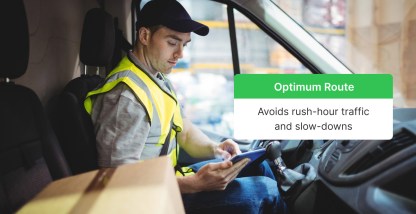In this article we will explain vehicle telematics and how it can be used to improve safety while also saving time and money. Read on to learn what you need to know about vehicle telematics and why, including:
- What is telematics?
- Why install a telematics device?
- What are the benefits of telematics?
- What are telematics services?
What is telematics?
Telematics is a coined term that combines the words “telecommunications” and “informatics.” The use of in-vehicle equipment such as GPS systems, along with communication systems, helps telematics provide various information and services.
Telematics is used to gather data using GPS technology, sensors, and on-board diagnostics codes. Managed data can include vehicle location, driver behavior, vehicle activity, and real-time engine diagnostics. The technology is managed on software platforms that help fleet owners manage their assets remotely.
Trucking companies will install telematics devices and accompanying software to collect and transmit a broad range of information. Depending on the type of device installed, that data might include:
- Vehicle maintenance information
- Vehicle location
- Vehicle usage (in hours)
- Fuel consumption
- Excessive acceleration
- Hard braking
- Hard cornering
- Vehicle faults
- Idling time
- Speeding
The data and information acquired and transmitted by the telematics device provide fleet managers in-depth insights across their whole fleet. Fleets can use these insights to:
- Minimize fuel waste and operating expenses
- Improve fleet safety
- Monitor asset locations
- Proactively identify maintenance issues
Why install a telematics device?
Progressive fleet managers see telematics as a crucial technology for vehicle fleet management. Safety is one of the best reasons fleet owners should install telematics. Options include in-vehicle coaching, driver behavior reporting, incident notification and reconstruction, and the ability to track stolen vehicles.
Improved customer service is another reason to install telematics in your fleet. The use of real-time GPS fleet tracking, trip reporting, and routing tools improve productivity and can help cut delivery times.
With a quality telematics system, dispatchers and fleet managers can track their fleet to accurately determine when their drivers are arriving. The ability to tell a customer exactly where their cargo is and precisely when it will arrive can quickly help build trust between the company and the customer.
Integration with onboard camera technology is another area where telematics may save the day. Motive customer Nybll, a California based health-centered food service provider, was involved in a collision. Thankfully, their driver was quickly exonerated due to video proof from an installed dashcam.
What are the benefits of telematics?
For the modern fleet manager, location tracking and monitoring of equipment, including engine and driver hours, can help provide more efficient operations and optimized use of resources. Some main benefits of this include:
Reduced fuel costs. With the use of telematics, fleet owners can better plan routes, cut idle time, and detect excessive fuel use from misuse of equipment and inadequate planning.
Communication and access to data. Telematics simplifies the communication process by reducing the need for drivers to check in and report back to the fleet manager by automating much of the process. This allows the driver more time to do their job and increases manager resources.
Safety. Telematics can improve safety management by monitoring driver behavior, vehicle, and equipment performance. In the event of an incident, GPS tracking can direct emergency assistance to the location where needed.
Cost-effective maintenance. Telematics can warn managers of critical mechanical issues allowing them to address the problem sooner, saving valuable downtime and costly repairs that could have been prevented. It can also make scheduling maintenance more timely, thereby maximizing resources.
Additional benefits may include:
- Increased efficiency and productivity of your fleet
- Improved safety
- Preventive vehicle maintenance monitoring
- Driver exoneration in refuting tickets or citations
- Driver exoneration after collision
- Reduced fuel waste
- Reduced operational expenses
- Optimized payroll management
- Automated IFTA reports
- Streamlined communication between vehicle and managers
What are fleet telematics services?
The primary role of telematics service providers is to collect real-time data generated by vehicles from GPS tracking and various devices and then transform it into a structured form for the fleet owner to be able to make accurate business decisions.
Measured driving data can include average vehicle speed, road type, hard braking, acceleration, elevation, hard cornering, g-force, and number of trips per day.
How can the Motive telematics solution help?
Fitting a telematics device into a truck is usually quite simple. Most vehicles manufactured after the mid-1990s have a port that is located near the steering column under the dashboard. Motive has an easy, step-by-step Vehicle Gateway installation guide that can help you install your device and avoid any potential problems.
The Motive Vehicle Gateway plugs into all standard 9-pin, 6-pin, or OBD-II diagnostic ports. Additionally, for certain vehicle models, Motive provides a special cable harness that connects behind the dash. For the 9-pin and 6-pin diagnostic ports, we also provide Y-cables, so you can hide the cabling behind a trim panel. By providing the VIN (or make, model, and year) when you order an ELD, the best cable for your vehicle will be assigned.
The Motive Dashboard can send messages to drivers in real-time through the Motive App. Using Motive Messaging can help streamline the driver’s daily workflow since they will have just one interface for messaging and compliance. Driver safety is always first — messages will not appear until the driver stops the vehicle.
To learn more about how telematics can help drive your fleet into the future, check out the Motive fleet management solution.








